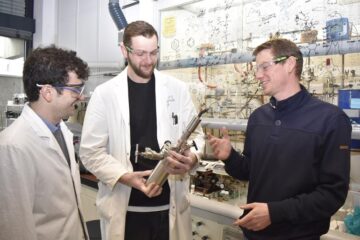Bacterial protein mimics host to cripple defenses

Like a wolf in sheep’s clothing, a protein from a disease-causing bacterium slips into plant cells and imitates a key host protein in order to cripple the plant’s defenses. This discovery, reported in this week’s Science Express by researchers at the Boyce Thompson Institute (BTI) for Plant Research, advances the understanding of a disease mechanism common to plants, animals, and people.
That mechanism, called programmed cell death (PCD), causes a cell to commit suicide. PCD helps organisms contain infections, nip potential cancers in the bud, and get rid of old or unneeded cells. However, runaway PCD leads to everything from unseemly spots on tomatoes to Parkinson’s and Alzheimer’s diseases.
BTI Scientist and Cornell University Professor of Plant Pathology Gregory Martin studies the interaction of Pseudomonas syringae bacteria with plants to find what determines whether a host succumbs to disease. Martin and graduate student Robert Abramovitch previously found that AvrPtoB, a protein Pseudomonas injects into plants, disables PCD in a variety of susceptible plants and in yeast (a single-celled ancestor of both plants and animals). Abramovitch and Martin compared AvrPtoB’s amino acid sequence to known proteins in other microbes and in higher organisms, but found no matches that might hint at how the protein works at the molecular level.
“We had some biochemical clues to what AvrPtoB was doing, but getting the three-dimensional crystal structure was really key,” Martin explained. To find that structure, Martin and Abramovitch worked with collaborators at Rockefeller University. The structure of AvrPtoB revealed that the protein looks very much like a ubiquitin ligase, an enzyme plant and animal cells use to attach the small protein ubiquitin to unneeded or defective proteins. Other enzymes then chew up and “recycle” the ubiquitin-tagged proteins.
To confirm that AvrPtoB was a molecular mimic, Martin and Abramovitch altered parts of the protein that correspond to crucial sites on ubiquitin ligase. These changes rendered Pseudomonas harmless to susceptible tomato plants, and made the purified protein inactive. AvrPtoB’s function is remarkable not only because its amino acid sequence is so different from other ubiquitin ligases, but also because bacteria don’t use ubiquitin to recycle their own proteins.
“An interesting question is where this protein came from,” Martin noted. “Did the bacteria steal it from a host and modify it over time, or did it evolve independently? We don’t know.”
Regardless, the discovery “helps us understand how organisms regulate cell death on a fundamental level,” Martin said. AvrPtoB provides a sophisticated tool researchers can use to knock out PCD brought on by a variety of conditions, shedding light on immunity. The protein itself or a derivative might one day be applied to control disease in crops or in people. For now, Martin and Abramovitch are working to find which proteins AvrPtoB acts on, and what role those proteins play in host PCD.
Media Contact
More Information:
http://www.cornell.eduAll latest news from the category: Life Sciences and Chemistry
Articles and reports from the Life Sciences and chemistry area deal with applied and basic research into modern biology, chemistry and human medicine.
Valuable information can be found on a range of life sciences fields including bacteriology, biochemistry, bionics, bioinformatics, biophysics, biotechnology, genetics, geobotany, human biology, marine biology, microbiology, molecular biology, cellular biology, zoology, bioinorganic chemistry, microchemistry and environmental chemistry.
Newest articles

Lower dose of mpox vaccine is safe
… and generates six-week antibody response equivalent to standard regimen. Study highlights need for defined markers of mpox immunity to inform public health use. A dose-sparing intradermal mpox vaccination regimen…

Efficient, sustainable and cost-effective hybrid energy storage system for modern power grids
EU project HyFlow: Over three years of research, the consortium of the EU project HyFlow has successfully developed a highly efficient, sustainable, and cost-effective hybrid energy storage system (HESS) that…

Safer alternative for an explosive reaction
The chemical industry has been using a reaction with explosive chemicals for over 100 years – now Mülheim scientists have discovered a safer alternative. The Ritter Group of the Max…





















